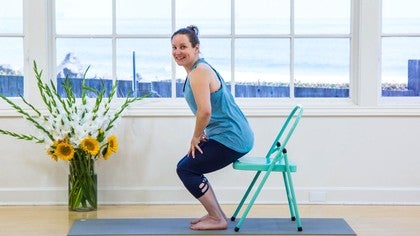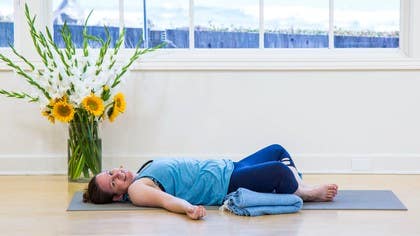Description
About This Video
Transcript
Read Full Transcript
Our pelvic floor does so much and yet no one is talking about it. Everyone has a pelvic floor, men and women, and it has amazing functions. So you can think of the five S's of the pelvic floor. It supports our pelvic organs, so all of the organs that are in the pelvis. It's also working to stabilize the spine and the pelvis. It has a sump pump action, so each time we breathe the diaphragm and the pelvic floor move down on the inhale, on the exhale they come back up, and it's moving the lymph in the body each time we breathe. It also has a sexual function and a sphincter function. So the sphincter one is so that we can eliminate when we want to and not eliminate, not go to the bathroom when we don't want to. So the pelvic floor is super important and it can affect the entire body and vice versa. So today we're gonna do a practice where we really get into some movement to explore pelvic floor and to see how we can lengthen and strengthen the pelvic floor at the same time. So first bring your hands to your rib cage and feel the breath coming into the rib cage. So it will expand on the inhale and exhale, the rib cage will come back towards itself. And just with this breath here now, the diaphragm and the pelvic floor are moving down on the inhale and on the exhale they're moving back up. So it's pretty subtle movement but this is that sump pump action that's happening. And all we really have to focus on to get that breath is to think about this expansion at the entire rib cage, kind of like an umbrella opening up, as well as having alignment of the spine. And then it just naturally happens. So just awareness of the breath is one of the most important tools for our pelvic health. So if you're driving in the car you can hold on or you can imagine the rib cage expanding into the back of your seat. You can have this umbrella visual as well and that is kind of the most important piece to rib cage breath. Then standing with feet hip distance apart let's do a little mini hip hinge where we bring hands to the front of the hips and then just start to fold forward bend the knees a little bit and imagine the sitz bones moving away from each other as you fold forward and as you stand bringing the sitz bones back towards each other. So the sitz bones expand away from each other and just a tiny hinge forward and then they move back towards each other as we stand. So we'll do that a couple more times. See if you can notice if it feels like we're not allowing that to happen. If we were tucking the tailbone as we were hinging forward then we want to see if we can let the sitz bones move away and untuck there. So on our pelvis if we look here we have our pelvis you have your pelvis at home and then I have an extra pelvis here. We can see that from the pubic bone to the tailbone is where the pelvic floor is running from front to back and then also from sits bone to sits bone. So this mini hip hinge that we just did is lengthening those muscles and we need to lengthen the muscles in order to strengthen them. It's lengthening those muscles as we hinge forward a little bit and we're going to do some more movements with this. So pelvic floor either requires more tone or less tone or both. The pelvic floor if it's hypertonic and it's really holding on that means it needs a little less tone. If it's hypotonic then it needs a little more tone. So we're going to do some movements that will do both. So let's come down to the floor. Come down to lying on your back with the knees bent. So from here lying on your back imagine drawing a triangle. So we'll imagine a triangle shape at the pelvic floor. So the front of the triangle is our pubic bone, the back of the triangle is the tailbone and the sides of the triangle are the sits bones. And from here we're just going to draw with our pelvis. We're going to bring the pelvis into a tilting motion. As we inhale then tailbone will press down into the earth and as we exhale tailbone will lift up pelvis will tilt back. So on the inhale it's like we're opening up the abdomen a little bit more, pelvis tilts away, and on the exhale then pelvis tilts toward. And just notice we can do a little bit less if it feels like it's uncomfortable or we could bring some padding in back behind the pelvis, maybe a blanket or a pillow. So notice how the pelvis tilts here. So that gets into the muscles, this is a lot like Cat-Cow, but it gets into the muscles running front to back on the pelvic floor. Pelvic floor is really cool because it's made of many layers, it's not just one solid muscle, there's many layers of muscle. And then bringing hands towards your ASIS bones, those front to very front of the hip bones, we're going to imagine that we can roll a marble from one hip bone to the other, tilting a little bit, but notice if the knees want to sway. So if the knees start doing this, we're gonna not do that, but instead tilt the pelvis so that one hip bone comes up and it's very very subtle, and then we roll that marble to the other side. So the hip bones will lift up, my knees want to move, my even my face wants to scrunch up to help me do it, but see if you can imagine this marble rolling. And it might feel a little choppy, so I'm noticing, hmm, on the left side feels like a little, a little stuck. So we just, we're just noticing, we're going to do some movements that will probably help with that. And then we'll draw figure eight. So whatever way that feels like you want to draw that figure eight with the pelvis. And this is where my face really wants to scrunch up, and I notice, hmm, I can't seem to draw what is in my mind. Figure eight, my knees want to help, but that's okay. There's no right or wrong way, we're trying to see where it's a little sticky. And then reverse the direction of your figure eight. And are you still breathing? Because it's, it takes up a little bit of concentration here. Good, and then come back to center here and just notice anything in low back, anything in the pelvis. From either with legs bent here, I'm gonna extend my legs a little bit more, or legs extended all the way out. We're going to engage pelvic floor, so remember we drew that imaginary diamond in our mind, the very front of the pelvis, the back, and the two sides. We're gonna see if we can draw that in, almost like we're pulling the drawstrings of a hoodie sweater, and see if on the exhale we could draw in all of those four corners of that diamond. And on the inhale can we release that? So on the exhale there's just a very slight draw in. We could imagine how graceful jellyfish is when it's swimming. That's like drawing in. The face should be soft, you're not feeling like we're holding or clenching. Good, and then we'll see if we can really let that go, let go of any tension that we were kind of bringing in, drawing that up. Hugging one knee in towards you, and holding onto that knee with the hands, start to circle the knee, but notice, we'll make a circle here, notice where the leg and the knee really wants to do it. Can you allow your arm and your arm strength to move the leg? So already my leg is saying, no I can do this for you, let me help, but see if you can let the leg be heavy, and just notice if there are any places that feel stuck here. So we circle around one direction, then the other. It might be really small circles, might be larger circles, it might feel more like a square.
Good, and then we'll release that foot down towards the floor. Hug the opposite knee in, and again, let the leg get heavy first. Can you release that leg into the hand? For those of you who have lots of mobility in the hips, you might make even smaller circles. So it might feel like that will just open out to the side, so really allow the arm, the arm strength to move the leg. And we find both directions. What does it feel like if we move intuitively here? We have continuous breath, we have the alignment, we have movement, these are all of the components that benefit our pelvic health. Then we see, is this side different than the other side in any way? And what's happening is we're getting into that muscle tissue and the fascia in the pelvic floor in a really gentle way. We'll release that foot down towards the floor and come rolling over to the side, where we'll palpate pelvic floor. So as we come rolling over to the side, the knees will be stacked, hips are stacked. We're gonna hug the top knee in, and again, see if you can let the hand hold that leg, and then bring that hand towards the sitz bone. So finding sitz bone here, you might have to bend the knee, straighten the leg, move the leg around to find that sitz bone, and we'll wrap the hand in and feel for the pelvic floor there. So we can actually feel inside the sitz bone is where the pelvic floor is, and on the inhale we find our inhale, and we may even feel pelvic floor moving towards the hand, and on the exhale, pelvic floor will move away from the hand. Good. And if we can't feel it, it's okay, we're gonna try the other side. So we're gonna roll over to the other side and see if we can feel it on the other side. There are a few tricks here as well. Once you get over onto the other side, support the head there, hug the knee in, find the sitz bone, move the leg around until you sort of feel where that sitz bone is, wrap the hand in there, and then it might help to move the leg lower or higher here, so you can see. It might even help to have the the knees together or the leg resting on a block. So really find, and this side might be different than the other side. So we'll see if we take that inhale here, can we feel pelvic floor moving down, and on the exhale do we maybe feel it moving up. Not to worry if we can't feel it, it's really subtle, it's happening. Great, and then we'll lower the leg down, we'll see if that makes a difference then to our pelvic tilt now. So we'll move back to the back and see if our pelvic tilt becomes a little smoother. So we'll first start with tilting the pelvis away from us on the inhale, so we make a little more space there at the abdomen, and on the exhale pelvis tilts back towards you. Just bring an awareness, I'm noticing right away that my head really wants to move with it, so we can see that there's this whole wave of movement that happens in the spine. There's no wrong movement, it's just we want to play around and see what would happen if I went to move my pelvis and not my head. So is that, does that make it feel different, does that feel harder, or when I have that pelvic tilt and I allow the head to move with it, and does it feel different from when we started, when we did our first pelvic tilt. Then we'll tilt side to side, so we imagine this marble rolling from one hip bone to the other. So we have this side to side, and what do we notice? Do we notice? I notice now, ah my left, my left hip is much happier now. Sometimes we think that we have to do really amazing movements and really get in. The pellet floor is very subtle, it doesn't, it doesn't need big movements to get in there, it needs us to be really aware and get into the subtleties. So then let's try our figure eight together. I feel like some nice like smooth music would be nice for figure eights. My knees really want to move now, so what does it feel like if we try and might close your eyes, see if you can let the pelvis do the movement more than the knees, and then reverse the direction of that figure eight. Great, coming back to the center, hug both knees in, and again let the knees soften, let the legs soften, let the arms do the work here. So the arms are to straight, that's our inhale. On the exhale, can we hug the knees in. If the legs feel really far away today, let's bring a strap in behind the knees or a towel or a belt. So the inhale, the knees move away, the exhale, the knees move back towards you. It's gonna be really nice if we've just had a long day and our low back is feeling tender, if we want to wake up in the morning and get moving. Releasing the feet down, stretching the arms out to the sides, your choice if we have knees bent or legs extended. I'm gonna extend mine and take up lots of space if you were thinking of yourself as a starfish. Sinking into the sand here, closing the eyes, bringing your awareness back to that ribcage breath. Is there any way that you could shift or move to be a little more comfortable? Sending some love and some gratitude to pelvic floor.
You can stay here as long as you would like, otherwise starting to make small movements with fingers and toes, rotating wrists and ankles. Reaching out with arms and legs really lengthen the entire body. Getting ready to roll over to one side, using your hands to bring you up to sitting. So I hope this practice got you a little feeling like you're more connected to pelvic floor and the pelvis, feeling nice and relaxed, ready to take on the rest of your day. Thank you.
Yoga for Women's Health: Yoga For Pelvic Health
Comments
I'm pregnant on my 3rd trimester is that find if I practice this class ? Let me know thanks!
You need to be a subscriber to post a comment.
Please Log In or Create an Account to start your free trial.



















